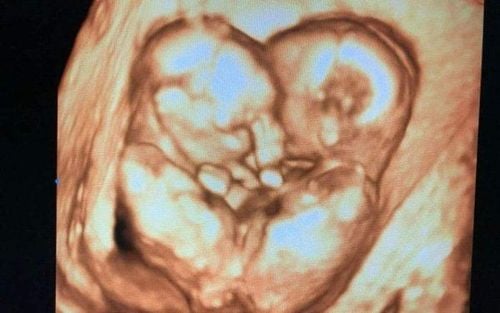This is an automatically translated article.
The article was professionally consulted with Specialist Doctor I Pham Thi Yen - Obstetrician-Gynecologist - Department of Obstetrics and Gynecology - Vinmec Hai Phong International General Hospital.The cause of conjoined twins is that the embryo splits only partially, instead of forming two separate individuals. Although there are two developing fetuses, they will be physically connected to each other - most commonly in the chest, abdomen or pelvis, and share one or more internal organs.
1. Types of Conjoined Twins
There are no specific signs or symptoms that indicate that the mother is carrying conjoined twins. As with other twin pregnancies, the uterus may grow faster than a single pregnancy. Pregnant women may experience more fatigue, nausea, and vomiting in the early stages of pregnancy. Conjoined twins can be diagnosed early in pregnancy with standard ultrasound.Conjoined twins are usually classified according to where they are joined. Sometimes, they even share organs or other body parts. Surgical separation of conjoined twins is the only treatment.
Common conjoined cases include:
Chest : Thoracopagus twins conjoined at chest, face to face. Two babies often share a heart, may also share a liver and intestines with each other. This is one of the most common cases of conjoined twins. Abdomen: Omphalopagus twins are connected near the abdomen, often sharing a liver and parts of the small intestine (ileum), colon. In this case they will have two separate hearts. Spinal root: Pygopagus twins are usually fused together at the base of the spine and buttocks. Some of these twins will share the same lower digestive tract, as well as part of the genitals and urinary tract. Along the spine: Also known as Rachipagus, twins are joined along the length of the spine. This form is very rare. Pelvic: Ischiopagus twins fused together at the pelvis, face to face. Multiple pelvic conjoined twins often share the same lower digestive tract, liver, genitals, and urinary tract. Each baby can be full 2 legs, the less common case is twins with only 2 or 3 legs. Trunk: Parapagus twins are joined at the pelvis and part or all of the abdomen and chest, but have separate heads. Twins can have 2, 3, or 4 arms, and 2 or 3 legs. Head: Craniopagus twins may be joined at the back, top, or sides of the head, except for the face. The two babies share a part of the skull. However, their brains are often separate, sharing only some brain tissue. Head and thorax: Cephalopagus twins conjoined on the face and upper body. The two faces will be on opposite sides of a common head, and the babies will also share the same brain. These conjoined twins rarely survive. In rare cases, one baby can be joined with another that is smaller and not fully formed - called asymmetric conjoined twins.
In extremely rare cases, it is possible to find another fetus developing the parasite inside the host fetus. This is called a fetus in fetu. In fact, these are identical twins, but one of the embryos divides too late, causing it to be completely enclosed by the other. Intrauterine pregnancy is less likely than conjoined twins, the chances of survival are higher, and removal of the parasitic fetus is also easier and less dangerous.
2. Causes of conjoined twins
Identical twins (monozygotic / identical twins) form when one egg is fertilized, then separate and develop into two individuals. 8-12 days after conception, the embryonic layers separate to begin developing into two fetuses, with separate organs and structures.
Another theory is that two separate embryos - could somehow fuse together during early development. This theory is called fusion, when the fertilized egg has separated, but the stem cells will find the same cells and stick (fuse) together.
The cause of either situation is still unknown. Because conjoined twins are so rare and the cause of conjoined twins is unclear, experts don't identify the risk factors that lead some couples to have conjoined twins.
3. Complications
Pregnancy with conjoined twins is complicated and greatly increases the risk of serious complications. Two conjoined babies require a cesarean section.As with other twins, conjoined babies are more likely to be born prematurely, one or both babies may be stillborn or die soon after birth. Serious health problems for conjoined twins can happen right away, such as breathing problems or heart problems. Complications later in life include scoliosis, cerebral palsy, or an inability to study normally.
Potential complications depend on the site of attachment, the organs or body parts shared, as well as the expertise and experience of the healthcare team. When a family is diagnosed with conjoined twins, the family and the doctor need to discuss in detail the possible complications, as well as the plan to prepare for next.
In the past, many conjoined twins were either not alive at birth (stillborn) or died shortly after birth. However, advances in surgery and modern technology today have improved survival rates. Some surviving conjoined twins can be surgically separated. The success of surgery depends on where they are joined and how many organs are shared, as well as the experience and skill of the surgeon.
Although the exact cause of conjoined twins has not been determined, doctors recommend that pregnant women should not be exposed to harmful chemicals, especially in the first 3 months of pregnancy. In addition, working closely with doctors, following regular antenatal check-ups and vaccinations to limit infectious diseases are also ways to ensure the normal development of the fetus.
Please dial HOTLINE for more information or register for an appointment HERE. Download MyVinmec app to make appointments faster and to manage your bookings easily.
Reference source: mayoclinic.org














